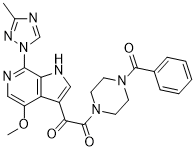This product is for research use only, not for human use. We do not sell to patients.

| Size | Price | Stock |
|---|---|---|
| 500mg | $1800 | Check With Us |
| 1g | $2450 | Check With Us |
| 5g | $6200 | Check With Us |
Cat #: V3503 CAS #: 701213-36-7 Purity ≥ 98%
Description: Temsavir (formerly known as BMS626529; BMS-626529) is a novel, potent attachment inhibitor that targets HIV-1 gp120 and prevents its binding to CD4+ T cells. Temsavir is also the phosphonooxymethyl prodrug of BMS-626529 that targets HIV-1 gp120 and prevents its binding to CD4(+) T cells. BMS-626529 had half-maximal effective concentration (EC(50)) values of<10 nm, with half-maximal effective concentration values in the low pM range against the most susceptible viruses.
Publications Citing InvivoChem Products
Product Promise

- Physicochemical and Storage Information
- Protocol
- Related Biological Data
- Stock Solution Preparation
- Quality Control Documentation
| Molecular Weight (MW) | 473.48 |
|---|---|
| Molecular Formula | C24H23N7O4 |
| CAS No. | 701213-36-7 |
| Storage | -20℃ for 3 years in powder formr |
| -80℃ for 2 years in solvent | |
| SMILES Code | O=C(N1CCN(C(C2=CC=CC=C2)=O)CC1)C(C3=CNC4=C3C(OC)=CN=C4N5N=C(C)N=C5)=O |
| Synonyms | BMS-626529; BMS 626529; BMS626529 |
| Protocol | In Vitro | Temsavir/BMS-626529 has half-maximal effective concentration (EC50) values of<10 nm='' against='' the='' vast='' majority='' of='' viral='' isolates.='' bms-626529='' exhibits='' an='' average='' ec50='' lai='' virus='' 0.4='' nm.='' 0.01='' most='' susceptible='' and=''>2,000 nM against the least susceptible virus. The cytotoxicity profile of BMS-626529 is examined in several cell types from different human tissues. CC50 values of >200 μM are observed in MT-2 (T lymphocytes), HEK293 (kidney), HEp-2 (larynx), HepG2 (liver), HeLa (cervix), HCT116 (colorectal), MCF-7 (breast), SK-N-MC (neuroepithelium), HOS (bone), H292 (lung), and MDBK (bovine kidney) cells measured after 3 or 6 days in culture. CC50 values of 105 and 192 μM are obtained in the T-cell line PM1 and in PBMCs, respectively, following 6 days in culture. These results show that BMS-626529 exhibits low cytotoxicity in cell culture[1]. BMS-626529 exhibits a broad spectrum of antiviral activity against a panel of clinical isolates, with a 50% inhibitory concentration (IC50) ranging from subnanomolar levels to >0.1 µM[2]. |
|---|
| Solvent volume to be added | Mass (the weight of a compound) | |||
|---|---|---|---|---|
| Mother liquor concentration | 1mg | 5mg | 10mg | 20mg |
| 1mM | 2.1120 mL | 10.5601 mL | 21.1202 mL | 42.2404 mL |
| 5mM | 0.4224 mL | 2.1120 mL | 4.2240 mL | 8.4481 mL |
| 10mM | 0.2112 mL | 1.0560 mL | 2.1120 mL | 4.2240 mL |
| 20mM | 0.1056 mL | 0.5280 mL | 1.0560 mL | 2.1120 mL |
This equation is commonly abbreviated as: C1 V1 = C2 V2
- (1) Please be sure that the solution is clear before the addition of next solvent. Dissolution methods like vortex, ultrasound or warming and heat may be used to aid dissolving.
- (2) Be sure to add the solvent(s) in order.




































